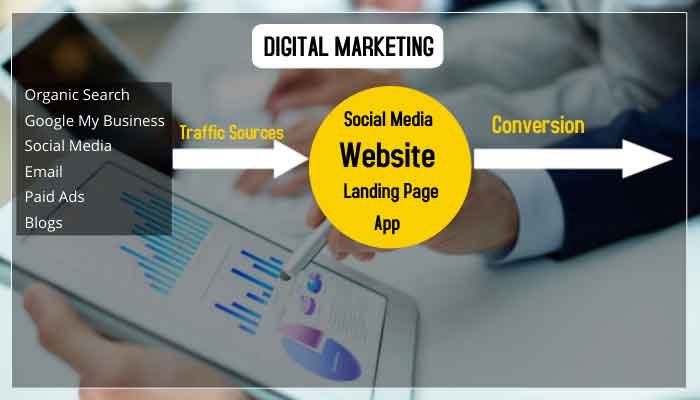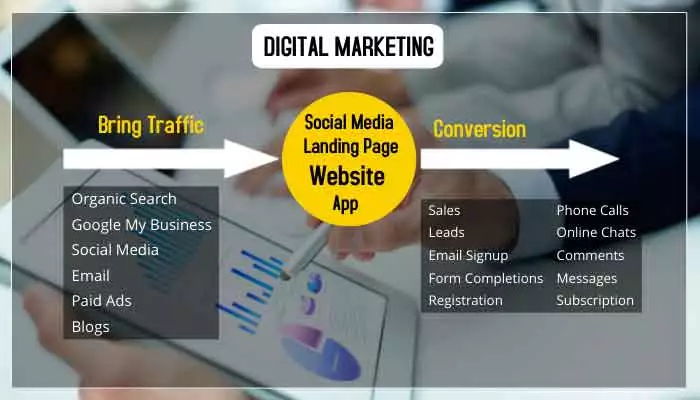Pervenire Digital Solutions Pvt Ltd
DIGITAL MARKETING: Know the hidden secret
Digital marketing is a data-driven marketing method in which advertisers market their products via the Internet on digital gadgets owned by users.
Everyone knows that marketing is the action of identifying your customer’s need/problem, enticing them with solutions through the means of your product or service, and then yielding a relationship.
But very few of us know Digital Marketing is also the same where you need to identify your customer’s need/problem and provide them with proper solutions.
The only difference is that Digital Marketing is merely leveraging data and advertising through digital channels with the help of the Internet and electronic devices.
What makes Digital Marketing different from other forms of marketing is the ability to track and measure results.
What this means for marketers is that they can determine which ads are most effective at reaching their desired audience, how many people viewed the ad (impressions), as well as who are those individuals were – demographics such as age, income level, location, etc. What marketers have at their disposal is a plethora of data.
Benefits of Digital Marketing
Reach the right people:
You can target your ads and send them to individuals that actually need what you’re offering (with an opt-in list or purchasing history). You can target your audience on the basis of demographics, interests, and behavior.
Take Control Of Your time:

Digital Marketing doesn’t require you to spend countless hours in the car driving around, schmoozing with people that have no interest in your services or products.
Increase efficiency:
What used to take several weeks or months can now be done within days depending on how much data is available and who needs it.
Save money:
What used to take you three hours of work might only require an hour with the help of technology, saving time and therefore money. What used to cost $100 will now cost $50. What used to cost $50 might now only require the inputting of data onto a computer with an hourly rate of $20.
Track your results:
Digital Marketing will allow you to track and measure everything that happens after you push the publish button, allowing for more precise decisions in where your marketing dollars are best spent (and which ads work best). What used to take several weeks or months can now be done within days depending on how much data is available and who needs it.
How Digital Marketing works?
The main objective of Digital marketing is to bring the targeted visitors from different channels and convert them into buyers/customers. If in a single line, this process can be called “Traffic Conversion“.
In order to achieve this target firstly, we need some platform where our customers are present so that we have an opportunity of pitching products/services which they actually want. Here digital marketers have brought lots of platforms such as Social Media Channels, websites, Landing pages, App, etc through these platforms traffic will be generated, and then we have to convert them with the help of our products and services.
Ways to Bring traffic for Digital Marketing?

What medium to choose for bringing traffic?
For this following questions should be answered firstly what you want from your customers
• How much budget do you have?
• What kind of products/services do you offer?
• How much traffic do you want?
• Which platform will be suitable for your business model?
Below are the some popular social media platform to bring traffic and create brand awareness.
1. Social Media:
The most common and trusted source of Digital Marketing is “Social media”. Facebook, Twitter, Linkedin, Pinterest, Youtube, Instagram, etc. are really helpful in getting huge amounts of traffic into our websites or landing pages. Here we have some strategies such as Facebook Page Likes Campaigns, Retweets on Twitter Channel, Followers on Instagram & Pinterest Platforms which will help us to grow the community base with targeted audience so that more people come for conversion easily.
2. Email Marketing:
Email is the cheapest way of Digital marketing where all we need to do is just send some informative emails at time intervals. It helps us in bringing new customers, increasing customer loyalty, and generating leads. Here marketers have different strategies through which they can promote their services/products like Facebook adverts with email signature or Gmail customized ads.
3. Google Search Engine Optimization (SEO):
SEO plays a vital role in bringing website traffic into our websites or landing pages because Google always tries to give the most relevant result so that users can easily find out what exactly they are looking for. There are lots of which play an important role here such as on-page SEO, off-page SEO, and lots of other activities.
4. Other Social Media
There are some social media channels through which we can bring traffic and they also have huge communities where marketers pitch their products/services to get more business leads or sales.
In my experience, I would like to recommend all the bloggers out there that you should choose among these following platforms such as redit, Instagram, Medium, Quora, etc because they are really helpful in making your blog popular with targeted audiences who actually come for conversion easily.
So far you have understood digital marketing benefits, how it works and how to bring traffic. Now we will look into the main objective of Digital Marketing ie: Conversion.
Conversion in Digital Marketing:
What is Conversion? So exactly what conversions are? There is a myth that only product selling or services are referred to as a conversion in digital marketing. This is completely absurd.
Conversion is the desired action taken by a visitor on your website, landing page, or app. Every time you see an increase in sales, leads, email signups, and form completions then that means conversions are working for you. Conversion can be from different sources like Search Engines Optimization (SEO), Social Media Platforms( SMO) , Electronic Devices & Mobile Applications etc.
Types of Conversion in Digital Marketing:
1. Sales
These types of Conversions refer to transactions between business websites, apps, or social media channels and visitors which result in direct sale/purchase orders being placed with brands online through their e-commerce store or digital marketing.
2. Leads
This refers to when users subscribe to receive newsletters and updates from brands through signups on their website, landing pages, or social media profiles.
3. Email signups
These types of Conversion refer to the number of forms that were completed by users during a specific session (or sessions) on your site; these can include: newsletter subscriptions, contact form submissions, inquiry forms etc.
4. Form completions
This is when visitors complete an online registration process in order to access premium content such as exclusive material and service benefits.
5. Subscription
Subscription Conversion refers to when subscribers add items into their shopping cart but do not purchase them right away- they will be charged only after the expiration date if they don’t cancel it beforehand.
6. Visits to a key page
If you have some important page which needs more attention than others like pricing details, special offers and other product details etc.
7. Online Chat
Chat conversions happen when a visitor to your website clicks the online chat button and starts communicating with an agent. The conversion rate for this type of conversion is open to interpretation, but in most cases, it ranges from .02% – .12%. With many people using web-based instant messaging applications like Facebook Messenger, Whatsapp, and GMB nowadays, we expect higher rates in the future since users don’t need to leave their favorite app anymore.
8. Comments
Comment conversions happen when a visitor to your website leaves a comment on the blog post of your choice. According to Hubspot, the average conversion rate for this type of conversion is .28%. This number will vary depending on what kind of content you are writing about, but it’s still looking pretty good considering that most people never leave comments on blogs at all!
Conclusion
Marketing is an ever-changing field. One of the most effective ways to stay on top of trends and keep up with new opportunities is by staying informed. Markets change, but there are some principles that will always be true about marketing – like understanding your audience’s needs and wants or investing in creativity.
That’s why we provide articles like this one to help you learn more about digital marketing so that you can make better decisions for your future projects!
If you’re looking for more information on how it all works, what platforms can be used (and which ones work best), or want a list of conversion tools every digital marketer should know, check out our blog posts! Let me know if any questions come up as well 🙂






